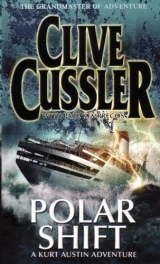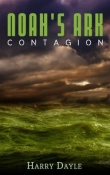
Текст книги "Polar Shift"
Автор книги: Clive Cussler
Жанр:
Научная фантастика
сообщить о нарушении
Текущая страница: 5 (всего у книги 26 страниц)
He contemplated his next move. It would be dangerous to go back to his house. He headed out of town toward Glacier National Park. Twenty minutes later, he pulled up in front of a small, ramshackle building. The sign outside said: glacier park wilderness TOURING COMPANY AND CAMPS. It was one of a number of businesses and real estate holdings Schroeder had invested in using straw companies. Behind the building were several camps he rented out in the warm season.
He parked behind the building, went inside a cabin he reserved for his own use and removed a moth-eaten moose head from over the fireplace to reveal a wall safe. He opened the safe with a few twists of the combination lock. Inside was a strongbox stuffed with cash, which he jammed into his parka pockets along with fake driver's licenses, passports and credit cards.
Schroeder went into the bathroom and shaved off his mustache. He tinted his hair brown to match the picture in his ID, and from a closet he pulled a prepacked suitcase. The change of identity took less than thirty minutes. Haste was of the essence. Anyone who could find a way through the web of fake identities that he had woven had to have considerable resources. It was only a matter of time before they tracked down the wilderness camps.
Someone might be watching the small airport in Kalispell. He decided to drive to Missoula and rent a car. Halfway to his destination, he stopped at a pay phone. Using a phone card, he called a longdistance number. As the phone rang, he held his breath, wondering if she would even remember him. It had been a long time. A man answered. They exchanged a few words and hung up. There was disappointment in his eyes.
Montana has no speed limit. As Schroeder pushed the truck to its limits, he wondered how the genie had once again escaped from the bottle. He was much younger the first time it had been contained, and he wondered if, at his age, he was still up to it.
He thought about the girl. Her portrait in his bedroom was taken by a commercial studio. They could trace it back. He thought his computer files were clean, but one could never tell. Then there were the phone records. He had grown careless in his old age. It was only a matter of time before they found her. He wondered what she looked like. The last time he had seen her was at her grandfather's funeral. He let his mind drift back, recalling the events that linked him to the young woman.
It was 1948. He was living in his log cabin in Montana. Although he had access through Swiss bank accounts to vast amounts of money, he eked out a living doing odd jobs and guiding tourists through Glacier National Park. One client, a businessman from Detroit, had left a magazine in his cabin. Schroeder did all the cleanup work himself, and he had glanced idly through its pages. That's when he discovered what had happened to Lazlo Kovacs since the night the Wilhelm Gustloff wentto the bottom.
The magazine article described a company set up by Dr. Janos, an enterprising World War II Hungarian refugee. His corporation was bringing an innovative array of consumer products to the market, all based on electromagnetic properties, making him a millionaire in the process. Schroeder smiled. There was no photograph of the reclusive inventor, but the Kovacs genius came through on every item.
It was the mud season in between skiing and trekking, so one day he packed a bag and took the train to Detroit. He found the Janos lab in an unmarked building. He had to ask several people in the neighborhood where the lab was.
He watched the front door from a parked car. The patience he had learned when stalking human beings was eventually rewarded. A Cadillac limousine pulled up to the building. Instead of stopping in front, it went around to an alley in the back. It took off before he could see who got in the car. He followed the car to the exclusive Grosse Pointe section of Detroit, where many auto executives lived. He lost the limo when it went through the gate of a walled estate.
The next afternoon, he was at the lab again. He parked where he had a clear view of the back alley. When the limo showed up, he got out of his car and walked over to the alley. The chauffeur, who was holding the door open, glanced at him but probably thought Schroeder was a bum to be ignored.
A man emerged from the back door and walked to the limo. He glanced in Schroeder's direction, started to get in the car, then he looked again. A wide grin came to his face. To the puzzlement of the limo driver, his wealthy employer went over and put his arms around the bum in a great hug.
"After all these years. What in God's name are you doing here?" Kovacs said.
"I thought you might like to take a ride in the snow," Schroeder said with a grin.
Kovacs responded with a look of mock horror. "Not if you are at the wheel."
"You're looking well, old friend."
"Yes, you too. Different, however. I wasn't sure at first. But it's the same old Karl."
"I shouldn't have come here," Schroeder said.
"Please, my friend, it was fated that we would meet again. I have so much to thank you for."
"Knowing that you are well and prosperous is thanks enough. Now I must go."
"We must talk first," Kovacs said. He told his driver to wait, and led the way back into the lab. "There is no one here," he said.
They passed through lab rooms filled with electrical contraptions that would have been at home in Frankenstein's lab and settled in a luxurious office.
"You've done well," Schroeder said. "I'm glad to see that."
"I've been very fortunate. And you?"
"I am happy, although my home isn't as rich looking as yours."
"You've been to my house? Of course, I should have known. You touch all the bases, as they say in our adopted country."
"You have a family?"
A cloud passed over Kovacs's brow, but then he smiled. "Yes, I remarried. And you?"
"There have been many women, but I continue to be a loner."
"Most unfortunate. I'd like to introduce you to my wife and daughter."
Schroeder shook his head. This was as far as it goes, he said. Kovacs said he understood. Schroeder's presence would raise too many questions. Both of them still had enemies in the world. They talked for another hour, until Schroeder finally asked the question that had been on his mind.
"I assume you have buried the frequencies?"
Kovacs tapped his forehead. "Up here, now and forever."
"You are aware that there was an attempt to capitalize on your work. The Russians found material at the lab and tried to make it work for them."
Kovacs smiled. "I am like the aunt who writes down her cookie recipe for the family but leaves out an important ingredient. Their experiments would have taken them only so far."
"They tried. Our adopted country conducted similar research, once the government found out what was going on. Then the experiments stopped."
"There is no need to worry. I haven't forgotten what my work did to my first family."
Satisfied with the answer, Schroeder said he had to go. They shook hands and embraced. Schroeder gave Kovacs an address to get in touch with him, if needed. They vowed to talk again, but years passed without contact. Then one day, Schroeder checked his blind box and found a message from the Hungarian.
"I need your help again," the message said.
When he called, the scientist said, "Something terrible has happened."
This time, Schroeder went directly to the Grosse Pointe mansion. Kovacs greeted him at the door. He looked terrible. He had aged well, the only visible change a graying of his hair, but there were dark circles under his eyes, and his voice was hoarse, as if he had been crying. They sat in the study, and Kovacs explained that his wife had died a few years before. Their son had married a wonderful woman, he said, but they were both killed in a car crash a few weeks before.
When Schroeder offered his condolences, Kovacs thanked him, and said there was one way he could help. He spoke into an intercom, and a few minutes later a nursemaid came in. She was holding a beautiful, blond baby girl.
"My granddaughter, Karla," Kovacs said, proudly taking the baby. "She is named after an old friend who, I hope, will soon be her godfather."
He handed the baby to Schroeder, who held her awkwardly in his arms. Schroeder was touched by the invitation and accepted the responsibility. As the girl grew up, he made several trips to Grosse Pointe, where he was referred to as Uncle Karl, and had become entranced by her grace and intelligence. On one occasion, she and her grandfather had spent several days in Montana. They were sitting on the porch of his log cabin, watching the girl chasing butterflies, when Kovacs revealed that he had a fatal illness.
"I am going to die soon. My granddaughter is well provided for.
But I want you to pledge that you will watch over her as you once watched over me and protect her from all harm."
"It will be my pleasure," Schroeder said, never dreaming that one day he would have to honor his pledge.
The last time he had seen Karla was at her grandfather's funeral. She had started college and was busy with studies and friends. She had developed into a lovely and intelligent young woman. He checked in with her from time to time to make sure she was well, and followed her career with pride. It had been years since they had seen each other. He wondered if she would recognize him.
He clenched his teeth in renewed determination.
Whatever it took, he knew he must get to her before theydid.
6
The intruder slithered through the dark water in an explosion of bubbles that scattered schooling fish like windblown leaves. As the five-foot-long torpedo flew through the sea, the transducer pulsing under its metal skin bounced high-speed bursts of energy off the bottom. An electronic ear collected the returning echoes, and the data from the sonar tow fish flew at the speed of light along an armored fiber-optic cable hundreds of feet long. The thick cable snaked onto the deck of the turquoise-hulled ship plowing a foamy wake through the ocean about two hundred miles east of the mid-Atlantic coast of the U.S.
The cable terminated in the survey control center on the ship's main deck. Austin sat in front of a glowing screen, analyzing the side-scan sonar images. A revolutionary undersea exploration tool invented by the late Dr. Harold Edgerton, side-scan allowed the quick survey of vast areas of ocean bottom.
A dark vertical line running from the top to the bottom of the screen showed the path of the survey ship. Broad color bands to either side of the line represented the port and starboard areas being probed by the side-scan sonar. Navigational data and time were displayed on the right side of the screen.
Austin stared at the screen, his face bathed in its amber light, alert to every visual nuance. It was a tiring job, and he had been at it for two hours. He had glanced away from the screen and was rubbing his eyes when Zavala and Adler stepped through the door. Zavala was carrying a thermos of coffee and three mugs that he had picked up in the mess hall.
"Coffee break," he said. He poured the mugs full and handed them around.
The hot coffee burned Austin's lips, but it gave him a welcome wake-up lift. "Thanks for the caffeine pick-me-up," he said. "I was getting bleary-eyed."
"I can take the next shift," Zavala volunteered.
"Thanks. I'll put the scan on autopilot for now, and show you and the professor what we've been doing."
Austin set the sonar monitor to buzz if it picked up an object larger than fifty feet in size, and the three men gathered around a chart table.
"We're running a medium-range search to cover the most ground possible without distorting the results," Austin said. "The ocean depth here is about five hundred feet. We've marked out twelve-mile squares along the assumed course of the missing ship." He drew his finger along the perimeter of a rectangle marked in grease pencil on a transparent overlay. "The survey ship follows imaginary parallel lines in each square like someone mowing a lawn. We're about halfway through this square. If we don't locate the ship in this spread, we'll continue to probe a series of overlapping squares."
"Anything interesting turn up?" Zavala said.
Austin made a face. "No mermaids, if that's what you mean. Lots of flat ooze with hard sediment mixed in here and there, boulders, dips and depressions, school fish and sea clutter. No sign of our ship-or anyship, for that matter."
Adler shook his head in frustration. "You wouldn't think it would be so damned difficult with all these electronic gizmos to find a vessel that's longer than two football fields put together."
"It's a big ocean. But if any ship can find the Belle,it's the Throckmorton"Austin said in reassurance.
"Kurt's right. The instrumentation on this ship can tell you the color of a tube worm's eyes at a thousand fathoms," Zavala added.
Adler chuckled. "Deep-ocean biology isn't my area of expertise, but I wasn't aware those remarkable creatures hadeyes."
"Joe is exaggerating, but only a little bit," Austin said with a smile. "The stuff available on the Throckmortonmakes a strong case for those who argue that humans can explore the deep ocean without getting their feet wet. Instead of being crammed into a submersible vehicle, here we are sipping coffee while the side-scan fish does all the work for us."
"And what do youthink, Kurt?"
Austin pondered the question. "There is no doubt that someone like Joe can build an underwater robot vehicle that can be programmed to do everything but bring you your newspaper and slippers."
A brilliant mechanic as well as engineer, Zavala had designed and directed the construction of numerous underwater vehicles, manned and unmanned, for NUMA.
"Funny you should mention that," Joe said. "I'm working on a design that will do all that and mix a damned good margarita too."
"Joe makes my point." Austin gestured at the screens lining the walls of the survey center. "But what's missing in the comfortable confines of this room is the hunger for the one quality that will keep the human race from atrophying like an unused limb. Adventure."
Adler smiled with pleasure at having made the right decision in going to NUMA for help. Austin and Zavala were obviously sharp-minded scientists, knowledgeable in arcane areas of ocean research. But with their athletic bearing, quick humor and good-natured camaraderie the two NUMA men seemed like throwbacks. They were more like eighteenth-century swashbucklers than the seagoing academics he was used to, with their fussy intensity and taciturn personalities. He lifted his coffee mug in a toast.
"Here's to adventure," he said.
The others raised their mugs. "Maybe it's time we had a wave scientist on the Special Assignments Team," Austin said.
An urgent buzzing from the sonar monitor cut short Adler's laughter.
Austin set his coffee aside and stepped over to the sonar screen. He watched the display for a few seconds. His lips widened in a smile and he turned to the professor. "You said earlier that you'd like to assess the damage to the Southern Bellebefore you tell us about the theories you've been toying with."
"Yes, that's right," Adler said. "I'm hopeful that I can learn why the Bellewent down."
Austin swiveled the screen so that the professor could see the spectral image of a ship lying on the ocean bottom five hundred feet below.
"You're about to get your chance."
The sea had wasted no time taking over ownership of the Southern Belle.
The ship caught in the powerful spotlights of the remote-operated vehicle was no longer the magnificent vessel that had once plowed across the ocean like a moving island. Its blue hull was covered with a greenish gray growth that gave the ship a shaggy-dog appearance, as if it had grown fur. Microscopic organisms had taken up residence in the seaweed, attracting schools of fish that nuzzled for food in the nooks and crannies of what had become a huge incubator for marine life.
The ROPOS ROV had been launched from the Throckmorton'sA-frame stern soon after Austin had notified the bridge that the sonar scan had picked up the ship's image. The vehicle was around six feet long, three feet wide and high, and shaped like a seagoing refrigerator. Despite its boxy shape, the ROV's design had gone far beyond the "dope on a rope" function of the earlier remote vehicles. It was a moving ocean laboratory capable of a variety of scientific functions.
The ROV carried two video cameras, twin manipulators, sampling tools, sonar and digital data channels. The vehicle was attached to the ship by a fiber-optic tether that provided communication and the transmission of live video and other data. Driven by a forty-horsepower electric motor, the ROV had rapidly descended the nearly five hundred feet to where the ship lay on the bottom in an upright position.
Joe Zavala sat at the control console piloting the boxy undersea robot with a joystick. Zavala was an experienced pilot who had logged hundreds of hours in helicopters, small jet and turboprop aircraft, but controlling a moving object hundreds of feet away required the deft hand of a teenage video game addict on the controls.
Keeping an eye on the video picture in front of him, Zavala guided the ROV as if he were sitting inside it. He used a firm yet gentle hand on the joystick, giving the vehicle subtle commands to compensate for shifts in current. With each move of the joystick, he had to be careful that the ROV didn't get tangled in its umbilical.
The mood was somber in the crowded remote sensing center. Crew and scientists had squeezed into the room after word of the Southern Belle'sdiscovery had spread throughout the ship. The silent spectators gazed at the ghostly images of the dead ship like mourners at a funeral bier.
Reality had set in after the initial excitement of the ship's discovery. Those who follow the sea know that the solid deck under their feet rests on an undulating liquid foundation of ocean water that is as treacherous as it is beautiful. Everyone on the Throckmortonknew that the sunken ship had become a tomb for its crew. All were aware that they could suffer the same fate. There was no sign of the men who had gone down with the Southern Belle,but it was impossible not to contemplate the last terrifying moments of the cargo ship's doomed crew.
Totally focused on his task, Zavala brought the ROV down to deck level and ran it over the deck from bow to stern. Normally, he would have to be careful that the vehicle didn't get tangled in the masts and radio antennae, but the Belle'sdeck was as level as a billiard table. The camera picked up ragged metal stubs where the cranes and booms used to handle cargo containers had been snapped off like toothpicks.
As the ROV soared over the aft end of the ship, its lights picked out a large rectangular opening in the deck.
Zavala murmured an exclamation in Spanish. Then he said, "The deckhouse is gone."
Austin was leaning over Zavala's shoulder. "Try searching the area immediately around the ship," he suggested.
Zavala worked the joystick, and the vehicle rose higher above the deck. It moved around the ship in an expanding spiral, but there was no sign of the deckhouse.
Professor Adler had been watching the show in stony silence. He tapped Austin lightly on the arm and led him to the far end of the room, away from the crowd clustered around the ROV monitor.
"I think it's time we talked," the professor whispered.
Austin nodded and returned to the control console. He told Joe he would be in the ship's recreation room, then he and the professor left the survey center. With the rest of the ship's complement working or watching the pictures of the Belle,they had the rec room to themselves. It was a comfortable space, with leather furniture, a television set and DVD, movie cabinet, pool table and Ping-Pong table, some board games and a computer.
Austin and Adler settled into a couple of chairs. "Well," Adler said, "what do you think?"
"About the Belle?You don't have to be Sherlock Holmes to deduce why it went to the bottom. The deckhouse was blasted off."
"We have the satellite pictures showing wave activity. There's no doubt in my mind that she was hit by one or more killer waves far bigger than anything we've seen before."
"Which brings us back to your theories. You were reluctant earlier to talk about them. Has finding the ship changed your mind?"
"I'm afraid my theories are out of the ordinary."
Austin leaned back in his chair and folded his hands behind his head. "I've learned that nothing is ordinary when it comes to the ocean."
"I've hesitated up to now because I didn't want to be labeled a humbug. It took years for the scientific community to accept freak waves as fact. My colleagues would rip me to shreds if they knew what I was thinking."
"We couldn't let that happen," Austin said reassuringly. "I'll respect your confidence."
The professor nodded. "When the empirical evidence of these waves became too strong to deny, the European Union launched two high-resolution-image satellites. The project was called Max Wave. The goal was to see if these waves existed, and examine how they might influence ship and offshore platform design. The European Space Agency satellites would produce 'imagettes,' covering an area just ten by five kilometers. Over a three-week period, the satellites identified more than ten freak waves all higher than eighty-two feet."
Adler went over and sat in front of the computer. He tapped the keyboard until an image of the globe appeared on the screen. The Atlantic Ocean was speckled with annotated wave symbols. "I'm using the census data from Wave Atlas. Each symbol denotes the location of a giant wave, its height and the date it was formed. As you can see, there has been an increase in wave activities over the last thirteen months. And in the size of these monsters as well."
Austin pulled up a chair next to the professor. He scanned the wavy symbols. Each symbol was annotated with the height and date of the event. The waves were randomly scattered around the world, except for several clusters.
"Do you notice anything unusual?"
"These four circular patterns are each spaced the same distance apart in the Atlantic, including the area we're in now. Two in the North Atlantic. Two in the South. What about the Pacific?"
"I'm glad you asked me that." He manipulated the globe until the Pacific Ocean came into view.
Austin whistled. "Four similar clusters. Strange."
"That's what struck me as odd too." A faint smile crossed his lips. "I've measured the clusters and found that they are exactly equidistant in each ocean."
"What are you saying, Professor?"
"That there appears to be a conscious plan at work here. These waves are the work either of man or God."
Austin pondered the implications of the professor's statement. "There is a third possibility," he said after a moment. "Man acting as God."
Arching a bushy eyebrow, Adler said, "That's out of the question, of course."
Austin smiled. "Not necessarily. Mankind has a history of trying to control the elements."
"Controlling the sea is another matter."
"I agree, although there have been crude but effective attempts. Dikes and storm barriers go back hundreds of years."
"I was a consultant on the Venice tidal gate project, so I know what you mean. Stopping the ocean involves a relatively simple concept. It's the engineering that becomes the challenge. The creation of giant waves would be far more difficult."
"But not impossible," Austin said.
"No, not impossible."
"Have you given any thought to means? Something like huge underwater explosions?"
"Highly unlikely," Adler said with a shake of his head. "You'd need an explosion of a nuclear level, and it would be detected. Any other ideas?"
"Not offhand," Austin said. "But it's definitely something that NUMA should investigate."
"You have no idea how happy I am to hear you say that," Adler said with relief. "I thought I was going crazy."
A thought occurred to Austin. "Joe wondered if the Trouts' work might shed some light on this mystery," he said.
"Sure, I remember. You mentioned that a couple of your NUMA colleagues are working on another research project in this area."
Austin nodded. "South of our position. They're with a group of scientists on the NOAA ship Benjamin Franklin,looking into the biological implications of the giant eddies in the Atlantic Ocean."
"As I said, I wouldn't rule anything out. It's certainly worth looking into."
"We can talk to them about their findings when we get back to port."
"Why wait?" Adler said.
Adler's fingers played over the keys and a Web site popped up on the screen, followed by a satellite image showing the mid-Atlantic coast. "The ocean satellite taking this picture can pick up an object as small as a sardine."
"Amazing," Austin said, leaning close to the screen.
Adler clicked the computer mouse. "Now we're seeing ocean water temperature. That wavy band of reddish brown is the Gulf Stream. The blue area is cold water, and those circular blobs in tan are warm water eddies. I'll zoom in on our ship."
He worked the computer mouse so that one of the tan-colored swirls filled the screen. The outlines of two vessels were now visible near the whorl.
"That blip is the Throckmorton.The other one must be your NOAA ship. Wow! This stuff still amazes me."
Austin leaned over Adler's shoulder. "What's that smaller circle in the southeast quadrant?"
Adler enlarged the image. "It's a separate eddy. Acting real funny. The numbers in the little boxes show water movement speed and level. The level within the swirl seems to be dropping while the water is moving at increasing speed." Adler's eyes were glued to the screen. The swirl, now almost a perfect circle, continued to grow. "Migod,"he said.
"What's the problem?"
The professor tapped the screen. "We seem to be looking at the birth of a gigantic whirlpool."








